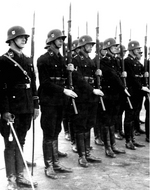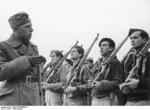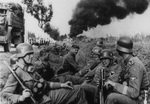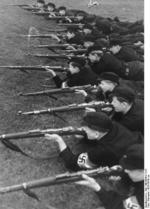Mauser Kar98k Rifle
| Country of Origin | Germany |
| Type | Rifle |
| Caliber | 7.920 mm |
| Capacity | 5 rounds |
| Length | 1.110 m |
| Barrel Length | 600.000 mm |
| Weight | 3.900 kg |
| Range | 500.000 m |
| Muzzle Velocity | 760 m/s |
Contributor: C. Peter Chen
ww2dbaseThe Karabiner 98 Kurz bolt-action rifles, also known as Kar98k or K98k, became the standard German infantry rifles in 1935. They hailed from the Gewehr 98 rifle design which was completed in 1898, which was developed into the Karabiner 98b design in 1924, and then shortened into the Karabiner 98k design. Although Kar98b and Kar98k rifles had the word "carbine" in the name, they were not technically carbines; the Kar98b had only been named so as a way to get around Treaty of Versailles restrictions placed upon Germany. Kar98k rifles were considered bulky and heavy compared to contemporary rifles, while the bolt-action might mean a slower firing rate; however, German soldiers reported that these rifles were preferred for their high accuracy. This notion changed later in the European War as they became overpowered by semi-automatic weapons wielded by Russian and American troops. Most snipers of the German Army were equipped with the sniper rifle versions of this design, which were equipped with Zeiss Zielvier 4x (ZF39), Zeiss Zielsechs 6x (ZF42), Ajack 4x, Hensoldt Dialytan 4x, or Kahles Heliavier 4x telescopic sights. In late 1944, the Kriegsmodell variant was introduced with simplified design to increase production; these rifles lacked the bayonet lug, cleaning rod, stock stick, and other features found in the prior Kar98k rifles. Between 1935 and 1945, about 14,000,000 Kar98k rifles of all variants were built; 132,000 of which were sniper rifles.During the war, Russian and other Soviet troops captured several million Karabiner 98k Kurz rifles of all variants. They were initially stored away in warehouses and factories in preparation for the potential escalation of the Cold War, but eventually they were shipped to communist revolutionary groups around the world, such as in the case of the communist forces during the Vietnam War. Some of the formerly occupied nations such as Norway and Romania also captured large stocks of Kar98k rifles as Germany surrendered in 1945, and used them as standard rifles in their military forces. Karabiner 98k Kurz rifles continued to be built after WW2 by firms such as Fabrique Nationale of Belgium and ?eská Zbrojovk of Czechoslovakia; many of the Czech-built rifles went to Israel, which were used, alongside other models of rifles, as standard rifles until the 1970s, seeing action in the Six-Day War in 1967 and the Arab-Israeli War in 1973. During the 1990s, many Kar98k rifles were seen during the conflict in Yugoslavia. Today, the Germany Army maintains a small stock of these rifles for military parades; there were also reports of Kar98k rifles being used in action against American and British forces in Iraq.
Source: Wikipedia. ww2dbase
Last Major Revision: Jun 2008
Mauser Kar98k Rifle Interactive Map
Photographs
 |  |  |  |
Você gostou deste artigo ou achou este artigo útil? Se sim, considere nos apoiar no Patreon. Mesmo USD $1 por mês já vai longe! Obrigado. Por favor, ajude-nos a espalhar a palavra: Fique atualizado com WW2DB: |
Visitor Submitted Comments
16 Oct 2009 06:41:53 PM
Mauser rifles are better that Mosins.. but I fancy the Mosin more.. why is this ??
6 Dec 2009 06:55:28 PM
The Karabiner 98K was based on the Mauser system. The weapon held 5 rds.of 7.92x57mm
loaded from a stripper clip into its internal
magazine.
The 98K was the basic version that the German Army used in W.W.I. It was designed a little shorter, than its W.W.I model. Every German Soldier trained with it,and it was the
basic Infantry Weapon.
The soldier was trained on other weapons, but
the 98K was the basic rifle. The rifle was produced until May 1945.
Post-War:
Millions of 98K's were captured by the Soviet
Union, the Soviets re-furbished them in the late 1940's and early 1950's. Like all Russian Military Equipment they were kept in storgage. Soviet bloc allies were issued them, many other countries in Europe used the
98K for years. Norway retired the last 98K's
in the 1970's.
Today the 98K is a collector weapon,and used by hunters and target shooters, others have been converted into fine hunting rifles.
As of 2005 the 98K's that were captured by the Soviets and re-furbished in the late 40's
and early 50's,have appeared on the civilian
market. The German Bundeswehr still use the 98K rifle for Military parades.
Since 1999 production of the Mauser M-98 has resumed in Germany by Mauser Jagdwaffen GmbH
(Mauser Huntingweapons Ltd.)
13 May 2011 10:37:19 AM
i received a 98k 100 year anniversary rifle.
can you give me some details and the value
of same?thank you
13 Dec 2013 12:13:21 AM
The German Mauser bayonet Model 98/22 was based upon the design produced originally for the Model 1898 Mauser rifle, and of which bayonet pattern there were innumerable variations manufactured during World War One. A new bayonet design was introduced in c.1922 and remained in service right up until the end of World War Two. Several variations existed, some having wooden grips, others with reddish-brown coloured synthetic material (bakerlite?) grips. The blade was 26cm long and the bayonet's fittings were often of blued steel.
14 Jan 2014 07:59:07 PM
I'm guessing that the German military wasn't happy when we created the 1903 Springfield
7 Dec 2014 09:30:42 AM
hy! y am from Romania and y whant to buy an full operatinal k98k, but y can't find one in my country. can someone help me???
26 Aug 2019 01:45:45 AM
Just wondering when it was made
17 Jan 2020 07:22:32 PM
What the hell does the 98 stand for?
18 Jan 2020 12:33:44 PM
To Anonymous of 17 Jan 2020: The "98" in the name is inherited from the original design, Gewehr 98, which was completed in the year 1898. Karabiner 98b (1925) and Karabiner 98k (1935) were both developed from the Gewehr 98 design, and both retained the "98" in their names.
12 Sep 2020 08:57:02 PM
I believe I have a K98b tuned down bolt carbine SN # H4691 . Left side of receiver stamped .DEUTSCHE WAFFEN-UND MUNITIONSFABRIKEN.BERLIN Can anyone give info on this rifle ?
15 Aug 2022 02:57:27 AM
The German Army used a standard 7,92mm rimless rifle and machine-gun cartridge, which had a variety of bullets. The basic infantry cartridge was the sS cartridge, a simple lead-cored fully jacketed round. It also had the SmK round which was cored with steel beneath a lead tip, again fully jacketed. A third type of round was the SmKL’spur, a cored tracer round, whose trajectory was similar to that of standard ammunition. This was particularly useful at night as it followed the same trajectory as the invisible non-tracer rounds that were being fired simultaneously. A fourth type was the incendiary bullet, which was filled with phosphorus.
All visitor submitted comments are opinions of those making the submissions and do not reflect views of WW2DB.
- » US Women's Army Corps "Six Triple Eight" Awarded with Congressional Gold Medal (30 Apr 2025)
- » Wreck of Soviet Submarine M-49 Found (10 Apr 2025)
- » Japanese Emperor Visited Iwoto (Iwo Jima) (8 Apr 2025)
- » Race, Holocaust, and African-American WW2 Histories Removed from the US Naval Academy Library (7 Apr 2025)
- » US Government Plans to Purge WW2 Information (17 Mar 2025)
- » Ver todas as notícias
- » 1,167 biographies
- » 337 events
- » 44,617 timeline entries
- » 1,244 ships
- » 350 aircraft models
- » 207 vehicle models
- » 376 weapon models
- » 123 historical documents
- » 261 facilities
- » 470 book reviews
- » 28,516 photos
- » 365 maps
Winston Churchill
Por favor, considere nos apoiar no Patreon. Mesmo R$1 por mês já faz uma grande diferença. Obrigado!
Ou, por favor, nos apoie adquirindo alguns produtos do WW2DB na TeeSpring. Obrigado!
29 May 2009 04:40:49 AM
in world war 1, the Germans shipped i think 10,000 Mauser karabiners (the old models) to the Irish rebels (IRA) fighting the British. however the ship was intercepted by a British naval ship in the German blockade